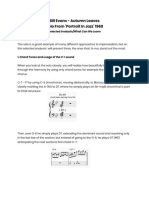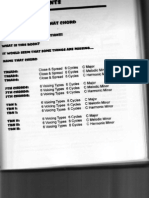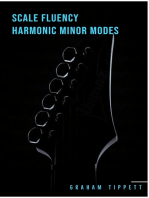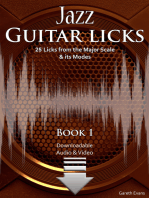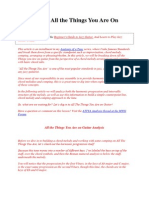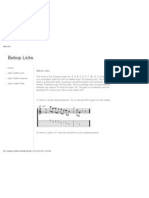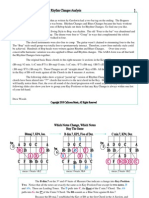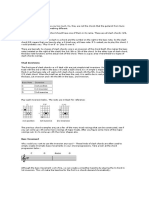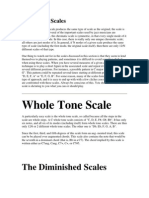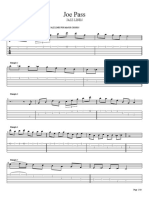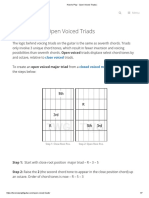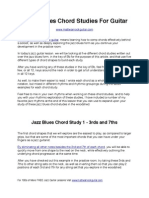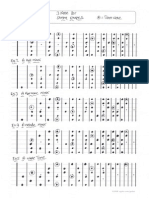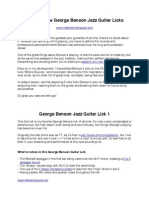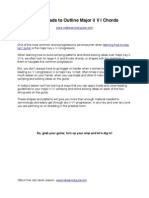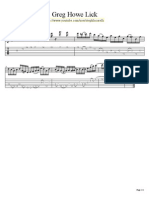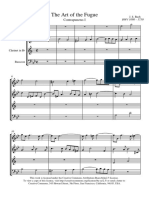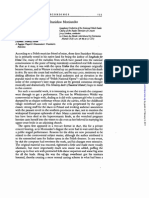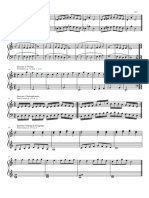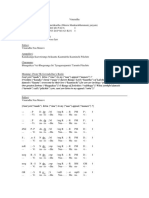Martino Chord Family
Martino Chord Family
Uploaded by
Srđan SarkanjacCopyright:
Available Formats
Martino Chord Family
Martino Chord Family
Uploaded by
Srđan SarkanjacCopyright
Available Formats
Share this document
Did you find this document useful?
Is this content inappropriate?
Copyright:
Available Formats
Martino Chord Family
Martino Chord Family
Uploaded by
Srđan SarkanjacCopyright:
Available Formats
PAT MARTINOS CHORD FAMILY METHOD PART 1 & 2 In Pats system of harmony there are only 2 chord family
y forms that do not change up and down the neck. Pat calls these Automatic chords because they retain their chord shapes and do not change as they move up and down the neck (Augmented chords are also automatic). 1. Diminished chords (Diminished Parent) 2. Augmented chords (Augmented Parent) For example, from the Diminished family comes all the dominants and minor chords. We will look at the Diminished chords. In Part 2 we will look at the Augmented form. PATS POSITIONS Lets take the E Diminished on the 3rd fret on string group 4 3 2 1 (E Bb C# G) Pat calls this the 1st Position (3rd fret); 2nd Position (6th fret); 3rd Position (9th fret); 4th Position (12th fret). His method evolves around this rule: by lowering any of the notes of the Diminished chord a half step you arrive at a Dominant 7th chord. Example 1: E Diminished (1st Position: 3rd Fret) E Bb C# G 1. By lowering the E a half step to Eb you arrive at Eb7 2. By lowering the Bb a half step to A you arrive at A7 3. By lowering the C# a half step to C you arrive at C7 4. By lowering the G a half step to Gb you arrive at Gb7 Example 2: G Diminished (2st Position: 6th Fret) G C# E Bb 1. By lowering the G a half step to Gb you arrive at Gb7 2. By lowering the C# a half step to C you arrive at C7 3. By lowering the E a half step to Eb you arrive at Eb7 4. By lowering the Bb a half step to A you arrive at A7 Example 3: Bb Diminished (3st Position: 9th Fret) Bb E G C# 1. By lowering the Bb a half step to A you arrive at A7 2. By lowering the E a half step to Eb you arrive at Eb7 3. By lowering the G a half step to Gb you arrive at Gb7 4. By lowering the C# a half step to C you arrive at C7
Example 4: C# Diminished (4th Position: 12th Fret) C# G Bb E 1. By lowering the C# a half step to C you arrive at C7 2. By lowering the G a half step to Gb you arrive at Gb7 3. By lowering the Bb a half step to A you arrive at A7 4. By lowering the E a half step to Eb you arrive at Eb7 This same rule applies to all other string groups for the diminished chord: 6541, 6432, 5432, 5321 plus all the other variation of string groupings that exist (to see all the possible groupings go to Pats web site and check out his chart on string groupings.) PATS SOLO METHOD Pat clearly claims in his instructional video and at the guitar workshops that he conducts that his technique or method for improvisation is not based on any theoretical approach as far as his thinking originating from any particular altered dominant scale, melodic minor and/or harmonic minor scales, or from any modal scale in design. Rather, Pat points out that his improvisational approach is purely built on experience and what he hears as a result of his years on the road. (Note: some jazz theorists have studied his approach and find areas of his solo work that may coincide with some traditional, and some not so traditional improvisational theory) DOMINANT SEVENTH = MINOR SEVENTH APPROACH Pats whole approach to the dominant seventh chord is to see (and hear) it as its minor 7th a 5th above. Example: G7 Pat plays Dm7 Bb7 Pat plays Fm7 C#7 Pat plays G#m7 E7 Pat plays Bm7 Example 1: E Diminished (1st Position: 3rd Fret) E Bb C# G 1. By lowering the E a half step to Eb you arrive at Eb7 .. PAT PLAYS Bbm7 2. By lowering the Bb a half step to A you arrive at A7 .. PAT PLAYS Em7 3. By lowering the C# a half step to C you arrive at C7 PAT PLAYS Gm7 4. By lowering the G a half step to Gb you arrive at Gb7 PAT PLAYS Dbm7
Example 2: G Diminished (2st Position: 6th Fret) G C# E Bb 1. By lowering the G a half step to Gb you arrive at Gb7 .. PAT PLAYS Dbm7 2. By lowering the C# a half step to C you arrive at C7 .. PAT PLAYS Gm7 3. By lowering the E a half step to Eb you arrive at Eb7 .. PAT PLAYS Bbm7 4. By lowering the Bb a half step to A you arrive at A7 PAT PLAYS Em7 Example 3: Bb Diminished (3st Position: 9th Fret) Bb E G C# 1. By lowering the Bb a half step to A you arrive at A7 .. PAT PLAYS Em7 2. By lowering the E a half step to Eb you arrive at Eb7 .. PAT PLAY Bbm7 3. By lowering the G a half step to Gb you arrive at Gb7... PAT PLAYS Dbm7 4. By lowering the C# a half step to C you arrive at C7 .. PAT PLAYS Gm7 Example 4: C# Diminished (4th Position: 12th Fret) C# G Bb E 1. By lowering the C# a half step to C you arrive at C7 PAT PLAYS Gm7 2. By lowering the G a half step to Gb you arrive at Gb7 .. PAT PLAYS Dbm7 3. By lowering the Bb a half step to A you arrive at A7 PAT PLAYS Em7 4. By lowering the E a half step to Eb you arrive at Eb7 .. PAT PLAYS Bbm7 12 KEYS IN 3 FRETS Pat explains that his method includes all 12 keys in 3 frets: If we work from the third fret E Diminished chord family we have the following, E Diminished Seventh (1st. Position: 3rd fret) E Bb Db G lowering each note a half step = Eb7 A7 C7 Gb7 F Diminished Seventh (1st Position: 4th fret) F B D Ab lowering each note a half step = E7 Bb7 Db7 G7 F# Diminished Seventh (1st Position: 5th fret) F# C Eb A lowering each note a half step = F7 B7 D7 Ab7 As you can see, all 12 keys are addressed within a 3-fret span and the same holds true in all positions up and down the neck.
PART II AUGMENTED FORMULA Play these triads on the fretboard (any way you can and then later see Pat's String Groups to employ the same): AUG. MAJORS 1. Abma+ (Ab C E) = Cma+ + Ema+ 2. Fma+ = Ama+ = Dbma+ 3. Bbma+ = Dma+ = Gbma+ 4. Bma+ = Ebma+ = Gma+ TRANSFORMATION OF AUGMENTED MAJOR TRIAD (Rel. Min/Rel.Maj): Take the Aug. Major Triad, and raise the fifth degree 1/2 step to get the Relative Minor - also lower the Tonic 1/2 step of any Rel. Minor to get the Aug. Major. 1. Abma+ (Ab C E) and raise the fifth degree to get Fmin(F Ab C) 2. Cma+ (raise the 5th) = Amin 3. Ema+ = Dbmin 4. Ama+ = Gbmin 5. Dbma+ = Bbmin 6. Fma+ = Dmin 7. Bbma+ = Gmin 8. Dma+ = Bmin 9. Gbma+ = Ebmin 10. Bma+ = Abmin 11. Ebma+ = Cmin 12. Gma+ = Emin DIMINISHED FORMULA (Move any single tone down 1/2 step and you get a Dom. 7th in 3 respective b3rds... 1. EDim7 (E G Bb Db) = Minor Thirds = V7 2. FDim7 = E7 3. F#Dim7 = F7 Eb7 = Gb7 G7 Ab7 = A7 Bb7 B7 Db7 D7 = C7
In other words, if you lower any tone in the Diminished chord
you get a relative dom. seventh.... E in Edim7 to Eb, you get Eb7 G in Edim7 to Gb, you get Gb7 Bb in Edim7 to A, you get A7 Db in Db dim7 to C, you get C7 You have to Check This Out For Yourself -- Get Your Guitar and play these functions.... [BONUS, add the b9 to these chords and you get the Diminished chords in enharmonic equivalents] For Example: EDim7 = C7b9 = E7b9 = G7b9 = Bb7b9 G Dim7 = E7b9, etc., etc Bb Dim7 = G7b9, etc.,etc. Db Dim7 = Bb7b9 etc., etc. Play all of the above on as many string groups as you can To see this concept clearer on the fretbaord Pat has come up with the following string groupings -The imporrtant thing to remember is that you must play all of the AUG. & DIM material discussed above on all these strings groups --(It virtually takes years -- but what JOY you will discover in Guitar Voicings...) NEXT.... Pat utilizes STRING GROUPS very interestingly compared to the Chinese IChing - 64 Hexagrams (see http://www.patmartino.com/) There are 64 String Groups (64 Hexagrams) -- the above chords have to be applied to the following string groups.... I thought this was crazy when Pat intoduced it to me -- however, it took me a few years to really visualize the concept -- it's GIANT. Once I understood how this works, I told Pat that it would virtually take years upon years to find all these voicings ... He said, "Yes, I know..., I'm still finding them..." ...and so am I .... everyday ...everytime I pick up the guitar I find a
new voicing(s).... HOW TO APPLY THE GROUPINGS.... For Example: Play Diads over two string groups (use 1 - 3, then 1 - 5, then 3 5, 1 - 7, 1 - b3, 1 - b7, etc. , etc. ... and expand...) THEN Play Triads over the Three string groups .... 1 3 5 .... 1 b3 5 1 3 b7 1 3 7 3 5 7 b3 5 1 5 7 3 7 3 r ... go on and on .... continue with voicings...do all configurations of the voicings in the Aug (Maj/Min), Dim/Dom. 7th. ) Play extensions: as the voicings increase when you add an extension like a 6th, 7th, 9th, 13, b5, b9, #5, #11, etc., the number of strings groups wiil have to increase -- in other words, to play C7 (CEGBb) you have to use the 4 string groups....etc., etc. STRINGS 6 String = #1 Full Use 5 STRING VOICING = 654321 --->#2 6543 1 --->#3 654 21 ---->#4 ... numbered etc..etc. following below 65 321 54321 4 STRING = 6543 654 2 654 1
65 32 65 3 1 6 432 6 43 1 6 4 21 6 321 5432 543 1 54 21 5 321 4321 3 STRING = 654 65 3 65 2 65 1 6 43 6 4 2 6 4 1 6 32 6 3 1 543 54 2 54 1 5 32 5 3 1 5 21 432 43 1 4 21 321 2 STRING = 65 64 6 3 6 2 6 1 54 5 3 5 2
1 43 4 2 4 1 32 3 1 21
1 STRING = 6 5 4 3 2 1 #64 = Silence Common 3 String Groups: 654 543 432 321 643 532 431 Common 4 String Groups 6543 5432 4321 6432 5321 See Pat's 64 Hexagrams of String Groups: http://www.patmartino.com/ When I studied with Pat I had already mastered Micky Baker's Jazz Ency. and Ted Green's Chord book -- I thought I had a pretty good handle on guitar voicings, BUT, when Pat intoduced me to this idea I was totally floored with the amount of voicings that could be found -and then try transposing these voicings in 12 keys (some will not
transpose for lack of space due to nature of the fretboard...) ...This is the most exciting thing I learned from Pat Martino ... As far as single line, besides the info above, I learned the most from playing his transcribed sols where his melodic concept is visualized on the fretboard (also available on his web site under "Transcriptions" Like I said ...I'm playing for 39 years, and everyday I find new voicings -- and I play everyday at least 1 - 4 hours ... See Pat's page: http://www.patmartino.com/ Play on...play on and Create ... Yes, You will find that it will take years but what else have you but time
You might also like
- Caleb Kelly Sound Whitechapel Documents of Contemporary ArtDocument240 pagesCaleb Kelly Sound Whitechapel Documents of Contemporary ArtHerbert Baioco Vasconcelos100% (3)
- 1.28.11.s.bailey - Micro CosmicDocument1 page1.28.11.s.bailey - Micro Cosmicsaccount01scrib100% (2)
- Bill Evans - Autumn Leaves Solo From Portrait in Jazz' 1960Document3 pagesBill Evans - Autumn Leaves Solo From Portrait in Jazz' 1960Cedric TutosNo ratings yet
- (Songbook) Antonio Carlos Jobim For Guitar and Voice PDFDocument73 pages(Songbook) Antonio Carlos Jobim For Guitar and Voice PDFVíctor Álvarez González89% (9)
- O Fortuna For Pep Band-Final VersionDocument9 pagesO Fortuna For Pep Band-Final Versiond_kelemenNo ratings yet
- Jazz Guitar Chord BookDocument30 pagesJazz Guitar Chord BookpatantikoynsNo ratings yet
- Jazz Guitar Licks: 25 Licks from the Melodic Minor Scale & its Modes with Audio & VideoFrom EverandJazz Guitar Licks: 25 Licks from the Melodic Minor Scale & its Modes with Audio & VideoNo ratings yet
- Drop 2 Chords PDFDocument17 pagesDrop 2 Chords PDFAlfa Kim007No ratings yet
- Voicing Modes Ebook SAMPLE PDFDocument19 pagesVoicing Modes Ebook SAMPLE PDFLemma Produzioni100% (4)
- Approach Notes and EnclosureDocument39 pagesApproach Notes and EnclosureAlfa Kim00780% (5)
- (Guitar Tab) Brett Garsed - Rock Fusion (Booklet) - 2 PDFDocument29 pages(Guitar Tab) Brett Garsed - Rock Fusion (Booklet) - 2 PDFSrđan Sarkanjac100% (1)
- Mick Goodrick - Voice LeadingDocument34 pagesMick Goodrick - Voice LeadingArcadio Lombardo95% (21)
- Mick Goodrick - Voice LeadingDocument34 pagesMick Goodrick - Voice LeadingArcadio Lombardo95% (21)
- Just Jazz Guitar May 2009 PDFDocument8 pagesJust Jazz Guitar May 2009 PDFSrđan Sarkanjac100% (1)
- Franz Joseph Haydn - Divertimento, Hoboken II: 14, For 2 Clarinets and 2 HornsDocument5 pagesFranz Joseph Haydn - Divertimento, Hoboken II: 14, For 2 Clarinets and 2 HornsRoss UberNo ratings yet
- Easy Beautiful Pieces For GuitarDocument2 pagesEasy Beautiful Pieces For GuitarFlorin Fanaj14% (7)
- Jazz Guitar Licks: 25 Licks from the Harmonic Minor Scale & its Modes with Audio & VideoFrom EverandJazz Guitar Licks: 25 Licks from the Harmonic Minor Scale & its Modes with Audio & VideoNo ratings yet
- CAGEDrules! Volume 2: Minor, Diminshed, Augmented ShapesFrom EverandCAGEDrules! Volume 2: Minor, Diminshed, Augmented ShapesNo ratings yet
- Jazz Guitar Licks: 25 Licks from the Major Scale & its Modes with Audio & VideoFrom EverandJazz Guitar Licks: 25 Licks from the Major Scale & its Modes with Audio & VideoNo ratings yet
- Fourths Tuning Chords and Inversions: Chords and InversionsFrom EverandFourths Tuning Chords and Inversions: Chords and InversionsRating: 5 out of 5 stars5/5 (1)
- Fastlines Jazz Guitar Method Primer: Fastlines Guitar Methods, #1From EverandFastlines Jazz Guitar Method Primer: Fastlines Guitar Methods, #1Rating: 5 out of 5 stars5/5 (1)
- Dorian Guitar Licks: 10 Original Smooth Jazz Licks with Audio & VideoFrom EverandDorian Guitar Licks: 10 Original Smooth Jazz Licks with Audio & VideoNo ratings yet
- Improvisation: C F E ADocument5 pagesImprovisation: C F E AotengkNo ratings yet
- Coltrane SubstitutionDocument7 pagesColtrane Substitutionsante cameroun100% (3)
- 5 Extended Jazz Guitar Arpeggio ExercisesDocument3 pages5 Extended Jazz Guitar Arpeggio ExercisesPedroMiranda50% (2)
- Drop Chords GuitarDocument26 pagesDrop Chords GuitarFrancesco100% (1)
- How To Play All The Things You Are On GuitarDocument14 pagesHow To Play All The Things You Are On Guitarbillsq0% (1)
- How To Play Minor Bebop Scales For Guitar Mattwarnockguitar PDFDocument13 pagesHow To Play Minor Bebop Scales For Guitar Mattwarnockguitar PDFSteven Orellana100% (1)
- Rhythm Changes The Ultimate GuideDocument60 pagesRhythm Changes The Ultimate GuideToroPolaco100% (4)
- Family of Four AnalysisDocument1 pageFamily of Four AnalysisLarry100% (2)
- Bebop LicksDocument3 pagesBebop LicksAlessio MicronNo ratings yet
- 5 Approaches To Soloing Over The Bridge To Rythm ChangesDocument11 pages5 Approaches To Soloing Over The Bridge To Rythm Changesvetah.ndaw1974100% (3)
- Drop 3 ChordsDocument39 pagesDrop 3 ChordsAlfa Kim007100% (1)
- Guide TonesDocument3 pagesGuide TonesMichael VochezerNo ratings yet
- Mattwarnockguitar Com Drop 3Document55 pagesMattwarnockguitar Com Drop 3pepe9eggNo ratings yet
- Three Common Melodic Outlines For Connecting Chords:: Bert LigonDocument2 pagesThree Common Melodic Outlines For Connecting Chords:: Bert LigongianNo ratings yet
- Embellishment and Substitution 1974-07-09Document5 pagesEmbellishment and Substitution 1974-07-09TomNo ratings yet
- Jazz Guitar ArpeggiosDocument5 pagesJazz Guitar Arpeggiosdiego82822100% (2)
- Giovanni Moltoni - Guit-NotesDocument23 pagesGiovanni Moltoni - Guit-Notesalessandro Pasqual100% (1)
- Intervals in Chromatic Scale (For Guitar)Document1 pageIntervals in Chromatic Scale (For Guitar)Brian Henderson50% (2)
- Guide Tones - Essential Exercises, Lines, and Patterns - MATT WARNOCK GUITARDocument16 pagesGuide Tones - Essential Exercises, Lines, and Patterns - MATT WARNOCK GUITARLouis Migliore75% (4)
- Rhythm Changes AnalisisDocument8 pagesRhythm Changes Analisismarcosmendez100% (2)
- Slash ChordsDocument11 pagesSlash Chordshsl2013100% (1)
- Microcosmic Bebop LineDocument1 pageMicrocosmic Bebop LinemiomirmNo ratings yet
- Comping With Bass LinesDocument4 pagesComping With Bass Linesprimus2No ratings yet
- Wholetone DiminishedDocument2 pagesWholetone Diminishedkmdsax100% (1)
- Pentatonic SubsDocument4 pagesPentatonic SubsJazzGuy100% (2)
- How To Practice and Apply Back CyclingDocument9 pagesHow To Practice and Apply Back CyclingGerasimos Avlonitis100% (1)
- Joe Pass JAZZ LINESDocument10 pagesJoe Pass JAZZ LINESMich Lobo FloresNo ratings yet
- The Dominant Pentatonic Scale - Guitar Lesson With ShapesDocument9 pagesThe Dominant Pentatonic Scale - Guitar Lesson With ShapesMasanobu TAKEMURANo ratings yet
- Approach Note-GuitarDocument9 pagesApproach Note-GuitarAttoNo ratings yet
- 3 To 7 TriadsDocument6 pages3 To 7 TriadsgtrNo ratings yet
- Caged Part 1Document21 pagesCaged Part 1Alfa Kim007No ratings yet
- How To Play - Open Voiced TriadsDocument7 pagesHow To Play - Open Voiced TriadsWayne White100% (2)
- Guitar Lessons - Chromaticism PDFDocument3 pagesGuitar Lessons - Chromaticism PDFMarco Caputo100% (1)
- Jazz Guitar Definitive GuideDocument21 pagesJazz Guitar Definitive GuideJknoxvilNo ratings yet
- Jacob Wise Guitar MethodDocument94 pagesJacob Wise Guitar MethodmikiyasnNo ratings yet
- Bert Ligon Outlines 2Document3 pagesBert Ligon Outlines 2cabralbruno10100% (1)
- How To Play Bebop Scales On GuitarDocument2 pagesHow To Play Bebop Scales On GuitarJulio C. Ortiz Mesias100% (1)
- Descending II V ChordsDocument23 pagesDescending II V ChordsYann Fleatwood100% (1)
- Autumn Leaves - Chord Melody Lesson For Jazz GuitarDocument8 pagesAutumn Leaves - Chord Melody Lesson For Jazz GuitarINHO SongNo ratings yet
- Triad Spread VoicingsDocument2 pagesTriad Spread Voicingsdrewdrew525No ratings yet
- Reharmonizacion DiatonicaDocument2 pagesReharmonizacion DiatonicaDianelys Castillo100% (2)
- Exploring Joe Pass II V IDocument6 pagesExploring Joe Pass II V IPedroMirandaNo ratings yet
- Motive ImprovisingDocument15 pagesMotive ImprovisingJoy GohNo ratings yet
- Chapter 4 - Fourth-Based Intervallic Models: Exercise 4.1.3Document1 pageChapter 4 - Fourth-Based Intervallic Models: Exercise 4.1.3Agung JackNo ratings yet
- Mick Goodrick D Pedal 23 ModesDocument1 pageMick Goodrick D Pedal 23 ModesRodolfo Amaral de AlmeidaNo ratings yet
- 5 Jazz Blues Chord Studies2Document7 pages5 Jazz Blues Chord Studies2ernestobulNo ratings yet
- Modos PDFDocument11 pagesModos PDFwplaisNo ratings yet
- Guitar Jar Allan Holdsworth Lesson Lead Lines PDFDocument2 pagesGuitar Jar Allan Holdsworth Lesson Lead Lines PDFSrđan Sarkanjac67% (3)
- Guitar Jar Allan Holdsworth Lesson Scale ShapesDocument1 pageGuitar Jar Allan Holdsworth Lesson Scale ShapesSrđan Sarkanjac100% (2)
- Bloomfield Lesson 1Document5 pagesBloomfield Lesson 1Srđan SarkanjacNo ratings yet
- Bergonzi PatternsDocument2 pagesBergonzi Patternsatste100% (6)
- 5 Must Know George Benson Jazz Guitar LicksDocument5 pages5 Must Know George Benson Jazz Guitar LicksSrđan Sarkanjac100% (1)
- Major II V I Triads Matt Warnock GuitarDocument9 pagesMajor II V I Triads Matt Warnock GuitarSrđan Sarkanjac100% (1)
- Greg Howe LickDocument1 pageGreg Howe LickSrđan SarkanjacNo ratings yet
- JGL Autumn Leaves Melody Chords PDFDocument4 pagesJGL Autumn Leaves Melody Chords PDFHudsonNo ratings yet
- Watermelon Man Chord Solo PDFDocument6 pagesWatermelon Man Chord Solo PDFSrđan SarkanjacNo ratings yet
- Benson StellaDocument1 pageBenson StellaMichael Kent SmithNo ratings yet
- Altered Scale Primer PDFDocument7 pagesAltered Scale Primer PDFSrđan Sarkanjac100% (2)
- E Haich InicijacijaDocument84 pagesE Haich InicijacijamirkolicaNo ratings yet
- "Toccata and Fugue" Listening ActivityDocument3 pages"Toccata and Fugue" Listening ActivityBlanca Cuesta DuarteNo ratings yet
- OrchestrationDocument551 pagesOrchestrationSethTurner100% (4)
- The Lion King MedleyDocument25 pagesThe Lion King MedleyJoseAntonioMartínezMartínezNo ratings yet
- Sheet 1: Song Structure: Summer of 69Document3 pagesSheet 1: Song Structure: Summer of 69gauravv7No ratings yet
- (Free Com Dejonghe Koen Easy Pieces For Guitar Quartet 17369Document12 pages(Free Com Dejonghe Koen Easy Pieces For Guitar Quartet 17369xacoxNo ratings yet
- A Lesson With TPDocument3 pagesA Lesson With TPJorge BarataNo ratings yet
- Pink Floyd - Shine On You Crazy Diamond v1Document11 pagesPink Floyd - Shine On You Crazy Diamond v1Josue De La RosaNo ratings yet
- The Art of The Fugue: Contrapunctus IDocument7 pagesThe Art of The Fugue: Contrapunctus IEnrique VictoriaNo ratings yet
- HindustaniPercussion SQPDocument4 pagesHindustaniPercussion SQPChinmoy BhattacharyyaNo ratings yet
- House of The Rising SunDocument3 pagesHouse of The Rising SunNoveke JosiahNo ratings yet
- HalkaDocument3 pagesHalkaMarijanaDujovicNo ratings yet
- ISC Music SyllabusDocument9 pagesISC Music SyllabusAyon BhattacharyaNo ratings yet
- VersioniDocument115 pagesVersioniMaria Elena CaramellaNo ratings yet
- Techniques and Materials of MusicDocument5 pagesTechniques and Materials of MusicBen Mandoza100% (1)
- Abide With Me Robert W Smith Benninig BandpdfDocument1 pageAbide With Me Robert W Smith Benninig Bandpdfพงษ์พิทักษ์ ไตรยมาตย์No ratings yet
- Charlie Parker Story 1Document2 pagesCharlie Parker Story 1boarjibu_403563136100% (1)
- Grahabhēda in Svrāntāra VarietiesDocument23 pagesGrahabhēda in Svrāntāra VarietiesArnaud DidierjeanNo ratings yet
- Compositor SDocument2 pagesCompositor SDekzie Flores MimayNo ratings yet
- Learn The Basics of Indian Music For GuitarDocument11 pagesLearn The Basics of Indian Music For Guitarjfb292929100% (1)
- Piano Exercises For MetronomeDocument1 pagePiano Exercises For MetronomeKristeena YapNo ratings yet
- VinaradhaDocument3 pagesVinaradhaanoNyMousNo ratings yet
- Road Stories (Patrick Watson) - Dylan Young - The GazetteDocument6 pagesRoad Stories (Patrick Watson) - Dylan Young - The GazetteDylan YoungNo ratings yet
- Bach - Cello Solo - Suites For Recorder Flauto DolceDocument8 pagesBach - Cello Solo - Suites For Recorder Flauto DolcemaxNo ratings yet
- Repertorio Carlos PerezDocument5 pagesRepertorio Carlos PerezmiguelNo ratings yet
- The Lute, The Lute Player, The Music, The MusicianDocument8 pagesThe Lute, The Lute Player, The Music, The MusicianBob BaoBabNo ratings yet


